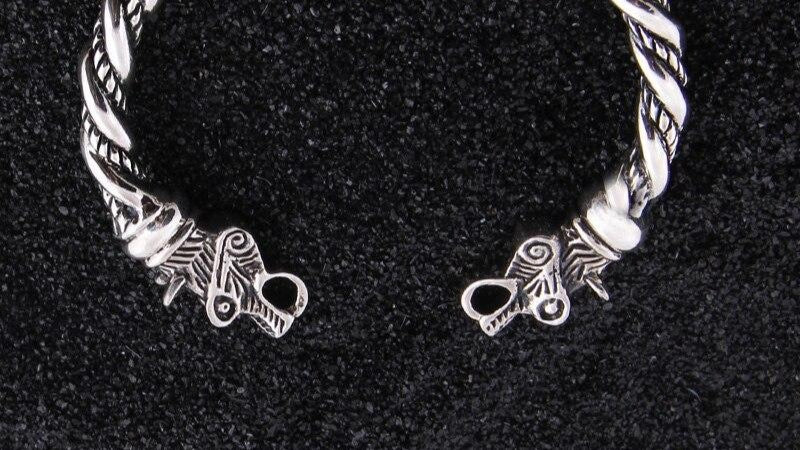The Viking Age, spanning from roughly 793 to 1066 AD, is renowned for its fierce warriors, epic sagas, and intricate craftsmanship. Among the many artifacts that have fascinated historians and enthusiasts alike, the Arm Ring, also known as Oath Ring, holds a unique place. More than just an adornment, a potent emblem of loyalty, honor and power in Norse culture.
Ragnar Lothbrok 999 Silver Bracelet
The Arm Ring or Oath ring was a physical reminder of the promises made. Oaths were sacred in Norse culture, and breaking one was seen as an act of great dishonor, a fate worse than death itself. An oath sworn was not only a sacred promise, but could also represent a legally binding agreement, and was often used during legal procedures, such as an oath of alliance to a noble or a king, or even an oath to speak the truth during judgments or testimonies.
In a world where written contracts were rare (most people could not read or write at all), the spoken word held immense power. Oath rings were often used during legal disputes or alliances, where individuals would swear to uphold their agreements. The ring acted as a tangible reminder of the oath, reinforcing the importance of keeping one's word.
One of the most famous examples of the oath ring's use in Viking society comes from the saga of Hakon the Good. According to the story, King Hakon, a Christian, was forced by his Pagan subjects to participate in a sacrificial ceremony. He reluctantly swore on the oath ring to honor the Old Gods, highlighting the deep cultural significance of the practice.
There are many more mentions of Oath Rings found within the Viking Sagas. In Eyrbyggia Saga a ring is described as being displayed on a stall in the midst of the floor. It states that on the stall “thereon lay a ring…on that all men must swear all oaths”.
There is also mention of an oath ring in the Anglo-Saxon Chronicle. We hear of King Alfred making peace with a massive Danish Army that invaded Wareham in 876. The Vikings swore an oath on the “sacred ring”, which is sometimes also translated as “bracelet”. The possibility of dual translations also backs up the idea of an arm ring, which might be given in an oath taking ceremony.
Even the All-Father Odin, is mentioned as having sworn an oath on a ring in the Havamal, in the stanza 108.
A ring-oath Odin I trow had taken --
how shall one trust his troth?
'twas he who stole the mead from Suttung,
and Gunnlod caused to weep.
(translation from the University of Pittsburg, link for the Havamal full translation here)
Sköll and Hati Sons of Fenrir 925 Sterling Silver Bracelet
Powerful chieftains often gave their retainers arm rings, upon which oaths of allegiance were sworn. The arm rings served as tangible objects that reminds of that oath, sometimes even identifying the chieftain one served.
For the chieftain it was an important part of Norse culture to be seen as the dispenser of gifts. These special rings could be given within heroic society to celebrate brave deeds or victories, further strengthening the bonds between chieftain and retainer. Arm-rings would also be a symbol of wealth, often made of precious metals, usually silver but sometimes gold.
Silver was actually more valuable than gold for a large period of time in human history (read more here). During the Viking Age, an ox would cost 2 öre (50grams) of silver. This corresponds to roughly 100,000 Swedish kronor or $9,610 today (source here).
Njord Bounty Bracelet in 999 Fine Silver
The God Ullr is closely related to Oath rings as it is mentioned in the Poetic Edda poem Atlakvida:
“So be it with thee, Atli!
- as toward Gunnar thou hast held
- the oft-sworn oaths,
- formerly taken -
- by the southward verging sun,
- and by Sigtý’s hill,
- the secluded bed of rest,
- and by Ullr's ring. ”
The only actual shrine to Ullr ever unearthed was in Sweden, in the city of Lilla Ullevi. In the earth, around it 65 rings were found with references to swearing on Ullr's ring, which indicates that he was one of the Gods who watched over a vow.

some of the arm rings excavated at Lilla Ullevi
While the Viking Age has long since passed, the legacy of the oath ring endures. Today, the oath ring is often worn as a symbol of heritage, strength, and integrity. It has become a popular motif in modern jewelry.
An Arm Ring represents a connection to the values of honor, loyalty, and the unbreakable bond of a promise. Whether worn as a personal token or given as a gift, the oath ring continues to embody the enduring spirit of the North.
The bracelet featured is the Odin Wolves Geri and Freki 925 Sterling Silver Bracelet available here.
Sources:
Eriksen, M. H. (2014). The Powerful Ring. Door rings, oath rings, and the sacral place.
Orchard, Andy. 1997. Dictionary of Norse Myth and Legend. Cassell. ISBN 0-304-34520-2
Jesse Byock (2005) Snorri Sturluson, The Prose Edda. 1st. edition. London, England: Penguin Books Ltd. ISBN-13 978-0-140-44755-2
Faulkes, Anthony. Edda. Trans. 1982. Oxford University Press. ISBN-13: 9781389651922
Jesch, Judith. 2015. The Viking Diaspora. Routledge. ISBN 9781138020795















